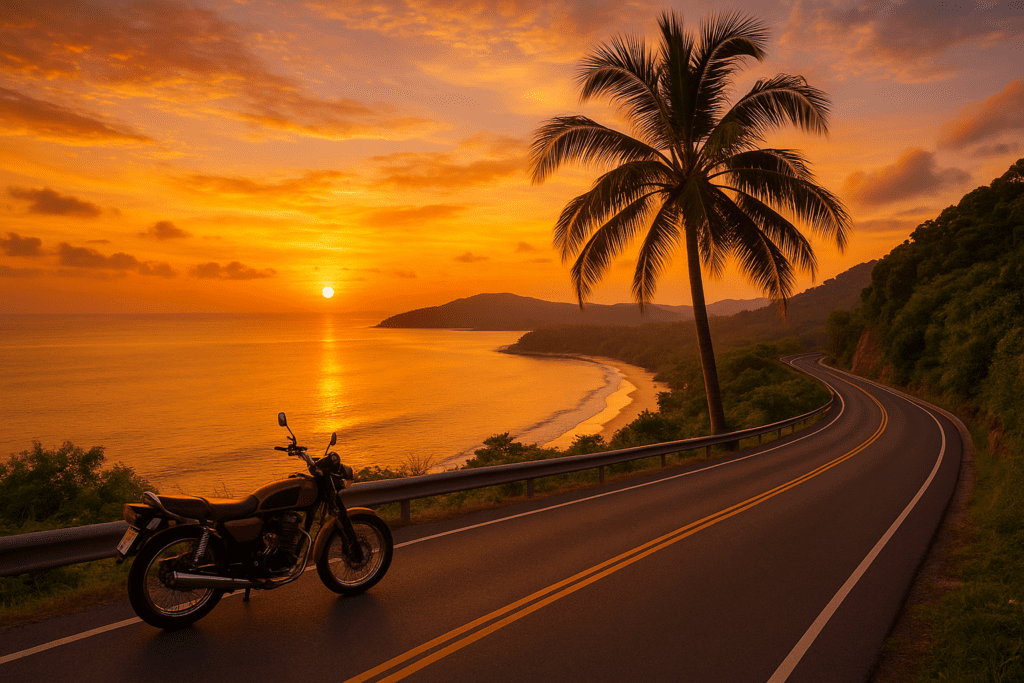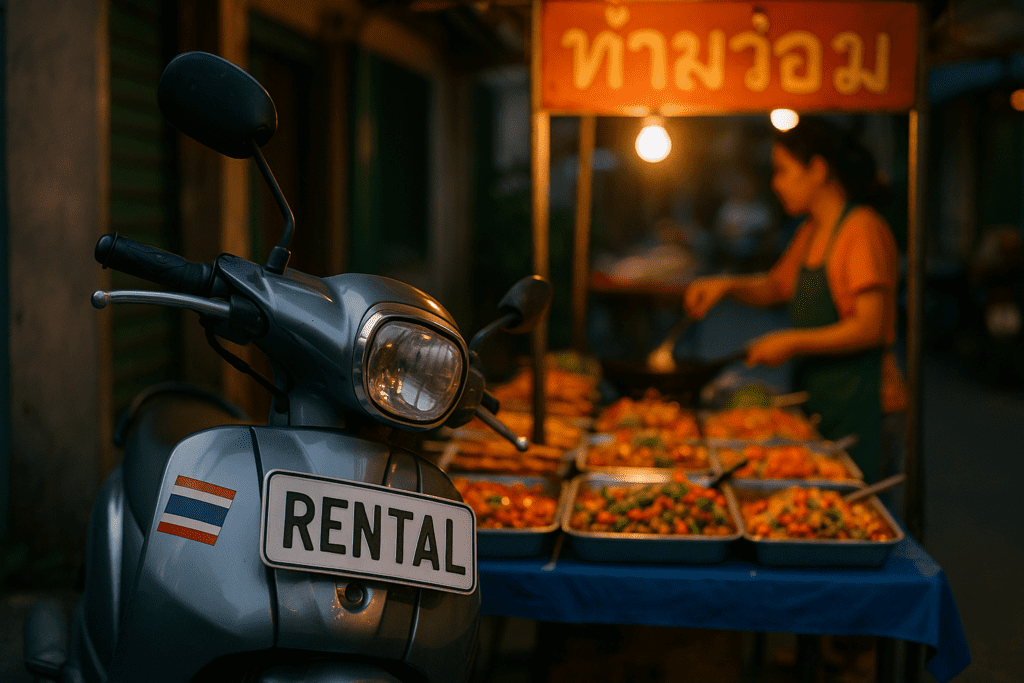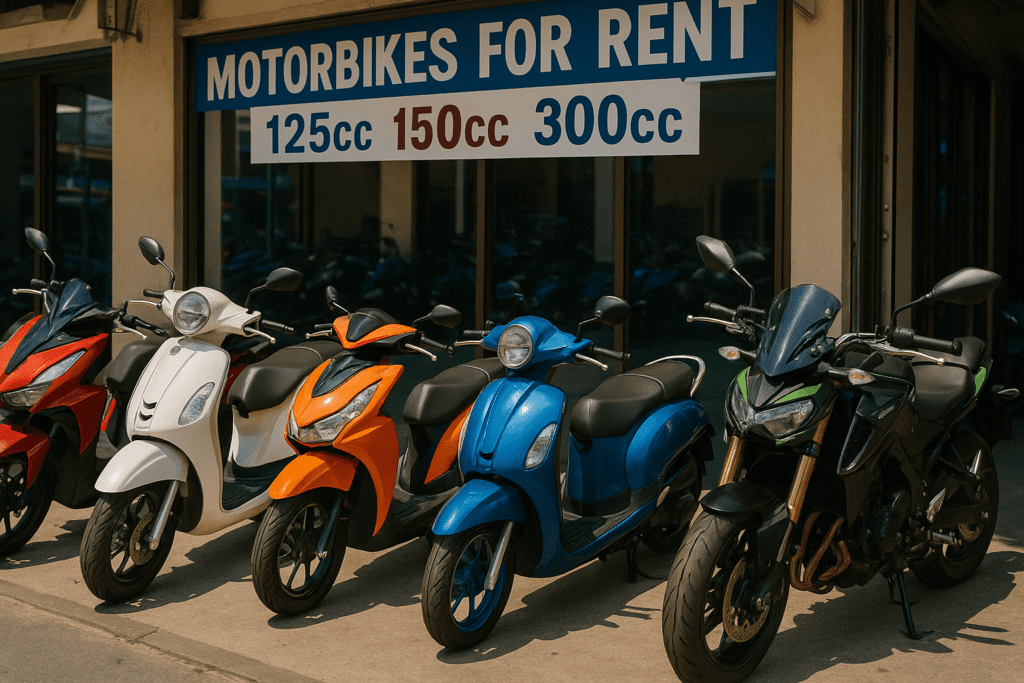🔑 Key Takeaways
- An International Driving Permit (IDP) with motorcycle endorsement is legally required – a car license alone is not sufficient
- Choose automatic scooters (110-150cc) for beginners and city travel; manual bikes only for experienced mountain riders
- Always pay cash deposit instead of leaving your passport with rental shops
- Take detailed photos/videos of the bike’s condition before rental to avoid damage scams
- Daily rental costs 150-250 THB ($4-6 USD), making it the most cost-effective transport option
- Wear helmets at all times and carry all required documents for police checkpoints
📋 Table of Contents
- Why Rent a Motorbike in Thailand? The Ultimate Freedom
- Choosing Your Ride: A Guide to Motorbikes and Scooters in Thailand
- Meeting the Thailand Motorbike Rental Requirements: What You Legally Need
- Your Pre-Rental Checklist: What You Need to Rent Motorbike Thailand
- The Step-by-Step Thailand Scooter Rental Process
- How to Rent Scooter Thailand: Online vs. Walk-ins and Negotiation
- Top Scooter Rental Tips Thailand for a Safe Trip
- Your Motorbike Hire Thailand Complete Guide: A Final Checklist
- FAQs & Troubleshooting
- Your Thai Adventure Awaits

Picture this: you’re cruising down a winding coastal road, tropical breeze in your face, pristine beaches stretching endlessly to your right. You spot a small food stall tucked between palm trees and decide to pull over for some authentic pad thai that no tour group will ever discover. This is the freedom that comes with exploring Thailand on two wheels.
This comprehensive motorbike rental Thailand guide will be your single most important resource for a safe and memorable adventure. Renting a scooter isn’t just the most affordable way to travel — it provides a direct, immersive experience with local culture and stunning scenery that you’ll never get from taxis or cars. Learn more about why motorbikes offer the best travel experience in Thailand.
Here’s what we’ll cover: choosing the right bike for your skill level, understanding the legal requirements (this part’s crucial), the step-by-step rental process, and expert tips to avoid the common pitfalls that catch so many travelers off guard.

Why Rent a Motorbike in Thailand? The Ultimate Freedom
Let me be straight with you — a motorbike is hands down the best transport option for your Thai adventure.
Unmatched Freedom and Flexibility
With your own set of wheels, you’re not tied to anyone else’s schedule. Want to chase that perfect sunset? Go for it. Stumble across a hidden waterfall mentioned by a local? You can be there in minutes. A motorbike unlocks access to secluded beaches, remote viewpoints, and local markets that are completely inaccessible to larger vehicles. While tour groups are stuck on their predetermined routes, you’re discovering places that don’t even have names on Google Maps.
Unbeatable Cost-Effectiveness
The numbers don’t lie. A standard 110-125cc automatic scooter costs between 150-250 THB per day — that’s roughly $4-$6 USD. Compare that to taxi fares (which add up fast), ride-sharing apps, or private car hires, and you’ll see why savvy travelers choose two wheels. For the cost of one day’s taxi rides in Bangkok, you could rent a scooter for an entire week.
A More Authentic Travel Experience
There’s a world of difference between being sealed inside a car and being part of the flow on a scooter. You feel Thailand — the tropical heat, the sudden afternoon rain, the smell of street food wafting from every corner. You’re not just observing the country through glass; you’re experiencing it. Traffic lights become opportunities to chat with locals. Every ride becomes an adventure where spontaneous discoveries happen naturally.

Choosing Your Ride: A Guide to Motorbikes and Scooters in Thailand
Not all bikes are created equal, and your choice can make or break your trip.
Understanding Engine Sizes
Most rental shops focus on 110cc to 150cc automatic scooters, and for good reason. These bikes are perfect for city travel, coastal roads, and short trips with one or two light passengers on paved surfaces. You’ll commonly see Honda Clicks, Yamaha NMAXs, and similar models dominating the rental fleets. They’re reliable workhorses that won’t leave you stranded.
If you’re a beginner, check out our The Best Motorcycles to Hire for Beginners in Thailand for a detailed breakdown of models ideal for first-time riders.
But if you’re planning to tackle steep mountain terrain — think Mae Hong Son loop or the winding roads to Pai — you might want something with more grunt. Watch this comparison of different engine sizes for Thai mountain roads. 150cc+ bikes and manual transmissions give experienced riders better control on challenging terrain, but they’re definitely not beginner-friendly.
Automatic vs. Manual Scooters
Here’s the breakdown:
Automatic Scooters:
- Pros: Extremely easy to operate with simple “twist and go” controls, ideal for beginners, and much smoother in the stop-and-go traffic that’s inevitable in Thai cities.
- Cons: Limited engine braking and less power when you’re tackling very steep hills or need quick acceleration.
Manual Scooters:
- Pros: More control over power delivery and gearing, which becomes invaluable on hilly terrain or when you need precise speed control.
- Cons: Requires clutch and shifting knowledge, which can be stressful for novices, especially in heavy traffic where you’re constantly stopping and starting.
Unless you’re an experienced rider planning serious mountain adventures, stick with automatic. Trust me on this one.
Meeting the Thailand Motorbike Rental Requirements: What You Legally Need
This section could save you thousands of dollars and massive headaches, so pay attention.
The License – The MOST Important Requirement
A standard car driver’s license from your home country is NOT legally sufficient to ride a motorbike in Thailand. I can’t stress this enough. You legally need one of two things:
- A Thai Motorcycle License
- An International Driving Permit (IDP) from your home country that specifically includes a motorcycle endorsement (usually stamped in the “A” category)
Here’s why this matters: riding without the proper license endorsement will void any insurance — both rental insurance and your personal travel insurance. If you have an accident, you’ll be personally liable for all medical costs, property damage, and legal fees. Learn about the serious legal consequences of riding without proper licensing.
Minimum Age
The official minimum age is 18, but many rental shops require riders to be at least 21. Some smaller, less scrupulous shops might bend the rules, but riding underage is illegal and nullifies any insurance coverage.
Deposit: Passport vs. Cash
Most shops demand a deposit — either your actual passport or cash ranging from 1,000 to 5,000 THB. I strongly recommend against leaving your passport. It’s your most important legal document, and you need it for hotels, domestic flights, and emergencies. Always offer a cash deposit instead. If a shop refuses cash and insists on your passport, walk away and find another place.
Understanding Insurance
Here’s where many travelers get caught off guard. The basic rental price often includes zero meaningful insurance. At best, it might cover theft of the bike itself. Most importantly, check your personal travel insurance policy to ensure it covers riding scooters abroad. If it doesn’t, you could face enormous medical and liability bills that’ll haunt you for years.
Mandatory Helmet and DUI Laws
Wearing a helmet is legally required for both driver and passenger. Police regularly set up checkpoints, especially in tourist areas, and issue on-the-spot fines for violations. The fines might seem small (usually 200-500 THB), but the real cost comes if you have an accident without proper protection.
DUI laws are strictly enforced, particularly at night checkpoints. Thai authorities don’t mess around with drunk driving, and penalties are severe.
Your Pre-Rental Checklist: What You Need to Rent Motorbike Thailand
Getting your documents and preparation right saves massive headaches later.
Documents to Bring
- Valid Passport: Even if you plan to pay a cash deposit, you’ll need to show your passport for identification purposes.
- International Driving Permit (IDP): Make sure the motorcycle endorsement is clearly visible and hasn’t expired.
- Original Driver’s License from your Home Country: The IDP is only valid when presented alongside your actual domestic license. Don’t leave home without both.
Payment Method
Cash in Thai Baht is king. Most rental shops prefer cash for both the rental fee and deposit. It’s faster, simpler, and gives you more negotiating power. Some larger, more established businesses accept credit cards, but don’t count on this option being available everywhere, especially on smaller islands or in rural areas.
Protective Gear
Shops are required to provide helmets, but inspect the quality carefully. Look for clean, undamaged helmets with working chin straps and no cracks in the shell. Many provided helmets are pretty basic, so consider bringing your own if you’re particular about safety gear.
I also recommend bringing or buying closed-toe shoes (never ride in flip-flops — I’ve seen too many scraped feet), riding gloves for better grip and protection, and long-sleeved tops to protect from sun and potential road rash.
The Step-by-Step Thailand Scooter Rental Process
Let me walk you through exactly what to expect during the rental experience.
Step 1: Research and Choose a Reputable Shop
Avoid random street stalls at all costs. Choose established shops with good online reviews on Google Maps or TripAdvisor. Shops in larger towns generally maintain their bikes better and offer more reliable service. For more in-depth local rental insights, read our Motorbike Rental Krabi: 4 Key Benefits & 200 THB Scooters, which covers regional rental advantages and tips. Using a trusted online platform can simplify this entire process — services like Byklo.rent vet their partners, helping you find reliable motorbike rentals without the guesswork.
Step 2: Inspect the Bike Thoroughly
This step is absolutely critical for avoiding bogus damage charges later. Take a slow-motion video and multiple time-stamped photos of the entire bike, focusing on any existing scratches, dents, or scuffs. Check the brakes (both front and rear), examine tire tread and pressure, and test all lights — headlight high and low beam, brake light, turn signals. Don’t forget to test the horn and adjust the mirrors.
Step 3: Complete Paperwork and Payment
Read the rental agreement carefully before signing anything. Check the daily rate, return date and time, and clarify any potential fines or fees. Provide your documents for their records, pay the rental fee, and hand over your cash deposit. Keep receipts for everything.
Step 4: Collect Keys and Emergency Information
Before you ride away, get the shop’s phone number and ask if they use messaging apps like LINE or WhatsApp for easier communication. This contact information becomes crucial if you break down or have an emergency. Ask them to show you the fuel gauge and clarify their fuel policy — some require you to return with a full tank.
Step 5: The Return Process
Return the bike on time to avoid late fees, which can be steep. Insist on inspecting the bike together with shop staff. This is where your pre-rental photos become invaluable if they try to claim new damage. Once everything’s cleared, collect your full cash deposit and/or passport, and get a receipt confirming the successful return.
How to Rent Scooter Thailand: Online vs. Walk-ins and Negotiation
Your booking method affects both price and experience quality.
Online Booking vs. Walk-In Rentals
Online Booking offers several advantages: you can reserve bikes in advance (essential during peak season), easily compare prices and reviews, and rely on user feedback for safety. Platforms like Byklo.rent make this process seamless by connecting you directly with pre-vetted local rental shops. The main downside is potentially less room for price negotiation.
Walk-in rentals give you maximum negotiating power, especially for longer rentals. You can physically inspect bikes before committing and often get better deals if you’re renting for a week or month. However, availability might be limited during busy periods, and it requires time and effort to walk around comparing different shops.
Negotiating Price and Duration
Daily rates are pretty standard, but weekly and monthly rentals offer significant discounts — sometimes 30-40% off the daily rate. Don’t be afraid to politely ask for better prices, especially if you’re renting for five or more days, during low season, or if you’re willing to take an older bike model.
For insights specific to Chiang Mai rentals, check out our Motorbike Rental Chiang Mai: 7 Insider Secrets That Can Save You $200+ Per Week, which details pricing hacks and scenic routes.
Clarify Fuel and Mileage Policies
Always confirm whether the bike should be returned with a full tank to avoid overpriced refueling charges from the shop. Most rentals include unlimited mileage, but it’s worth verifying since some budget operators might have restrictions.

Top Scooter Rental Tips Thailand for a Safe Trip
These tips come from years of experience and countless traveler mistakes I’ve witnessed.
Safety First, Always
Wear your helmet every single time you get on the bike, even for short trips around the corner. Carry copies of your passport, IDP, and rental agreement with you at all times. Thai police regularly check these documents at traffic stops, and having everything ready makes interactions smooth and friendly. For a broader set of safety guidelines, see our Top 10 Tips for Staying Safe While Riding a Motorbike in Thailand.
Watch for Hidden Fees
Be aware of extra charges that might not be clearly explained upfront: late return fees (often 50-100 THB per hour), excessive cleaning charges if you return a muddy bike, or inflated damage repair costs for minor scratches. Get all policies in writing or clearly stated before you rent.
Avoid Common Scams
The “pre-existing damage scam” is unfortunately common — shops blame you for old scratches and demand payment. Your detailed pre-rental photos are your best defense against this. Learn about other common motorbike rental scams to watch out for.
Another scam involves collaborators who puncture your tire, then a “helpful” local guides you to an affiliated repair shop that overcharges dramatically. If you get a flat tire, contact your rental shop first before accepting help from strangers.
Park Smart and Securely
Only park in designated motorcycle spots to avoid fines or having your bike towed. Bangkok and other major cities are strict about illegal parking. Always use the steering lock and consider bringing a small disc lock for extra security, especially if you’re parking overnight or in busy areas.
Your Motorbike Hire Thailand Complete Guide: A Final Checklist
Here’s your complete action checklist for a successful rental experience:
Pre-Rental Checklist:
- [ ] IDP with motorcycle endorsement and home license ready
- [ ] Detailed, time-stamped photos/video of scooter’s condition taken
- [ ] Brakes, lights, tires, and horn tested and working
- [ ] Insurance policy understood (or lack thereof acknowledged)
- [ ] Cash deposit provided instead of passport
- [ ] Shop’s emergency contact number saved
On-the-Road Checklist:
- [ ] Quality helmet worn at all times
- [ ] Driving on the left side of the road
- [ ] Speed limits observed (typically 60 km/h in towns, 80-90 km/h on highways)
- [ ] Avoiding unlit, rural roads at night
- [ ] Documents carried for police checks
Post-Rental Checklist:
- [ ] Fuel tank refilled (if required by rental agreement)
- [ ] Joint inspection completed with shop owner
- [ ] Full deposit and receipt confirming bike’s return collected
FAQs & Troubleshooting
Can I ride a rented scooter across the border to another country?
Almost certainly no. Rental agreements strictly prohibit taking their vehicles out of Thailand. Doing so would be a serious breach of contract and could result in theft charges if you don’t return the bike.
What should I do if I get stopped by the police?
Stay calm and be polite — this goes a long way in Thailand. Present your IDP, home license, and rental agreement. If you have all proper documents and are wearing a helmet, interactions are typically brief and friendly. Missing documents usually result in small, official fines that you can pay on the spot.
What happens if the bike breaks down or I have an accident?
Your first call should always be to the rental shop — they’ll advise you on next steps and may offer roadside assistance. For accidents involving other people or property, contact the Tourist Police (call 1155) and your travel insurance provider immediately. Learn more about accident procedures and legal requirements. Remember that without proper licensing and insurance, you’ll be liable for all damages and medical costs.
❓ Frequently Asked Questions
Do I need an International Driving Permit to rent a motorbike in Thailand?
Yes, you legally need an International Driving Permit (IDP) with motorcycle endorsement. A regular car license is not sufficient for riding motorbikes in Thailand.
How much does it cost to rent a motorbike in Thailand?
Standard 110-125cc automatic scooters cost 150-250 THB per day ($4-6 USD). Weekly and monthly rentals offer significant discounts of 30-40% off daily rates.
Should I leave my passport as deposit when renting a motorbike?
No, always offer a cash deposit (1,000-5,000 THB) instead of your passport. Your passport is crucial for hotels, flights, and emergencies. If a shop insists on passport deposit only, find another rental shop.
What type of motorbike should a beginner choose in Thailand?
Beginners should choose automatic scooters (110-150cc) with “twist and go” controls. Avoid manual bikes unless you’re an experienced rider planning mountain terrain.
What documents do I need to carry while riding in Thailand?
Always carry your passport copy, International Driving Permit, home country driver’s license, and rental agreement. Police regularly check these at traffic stops.
Is helmet wearing mandatory in Thailand?
Yes, helmets are legally required for both driver and passenger. Police issue fines of 200-500 THB for violations, and riding without a helmet voids insurance coverage.
Your Thai Adventure Awaits
Renting a motorbike truly is the most rewarding way to experience Thailand’s incredible diversity — from bustling cities to serene countryside, from mountain curves to coastal highways. But preparation and safety are absolutely non-negotiable.
This motorbike rental Thailand guide should give you the confidence and knowledge to plan your two-wheeled adventure properly. The freedom, affordability, and authentic experiences you’ll gain make the preparation effort completely worthwhile.
Ride defensively, respect local traffic rules, and embrace every moment of the journey. Thailand’s roads are waiting to show you adventures that no tour bus or taxi can provide.
Bookmark this page to reference the checklists during your trip. When you’re ready to find your perfect bike, head to Byklo.rent to book a motorbike with ease. Ride safe, and enjoy every kilometer of your Thai adventure!


